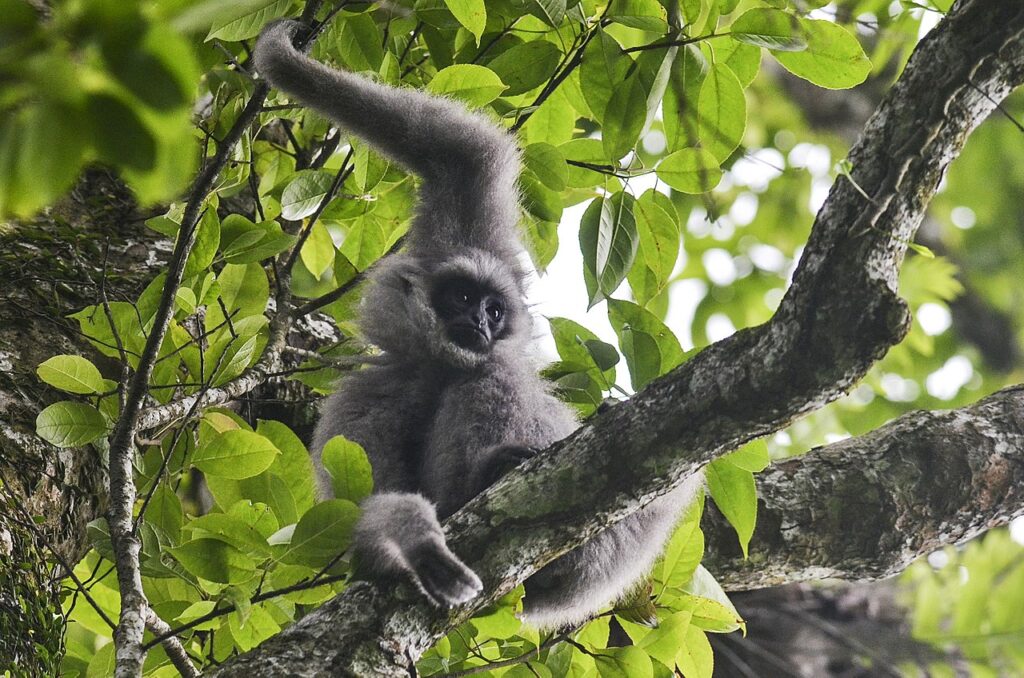In the intricate dance of global conservation funding, the silvery gibbon (Hylobates moloch) silently pirouettes on the edges of recognition, an unsung protagonist in the symphony of endangered species. While other flamboyant fauna command the spotlight, a quiet alliance between the International Union for the Conservation of Nature (IUCN) and the Aspinall Foundation whispers promises of salvation for these overlooked primates, orchestrating a poignant narrative of rescue and rehabilitation, a harmonious return to the untamed landscapes of Indonesia.
Casting shadows in the sanctuaries of protected enclaves and dwindling, solitary forests on Java’s western periphery, the silvery gibbon, classified as Endangered by the IUCN Red List, faces a precarious existence. In the heart of this ecological drama lies the Javan Primate Rehabilitation Centre (JPRC), an oasis within the Mount Tilu Nature Reserve, where 71 gibbons have sought refuge since the center’s inception in 2011, and 55 have found their way back to the wild.
Caught in the crossfire of poaching’s malevolence and the encroaching specter of deforestation, the silvery gibbon’s population teeters on the brink, a mere 2,500 resilient individuals defying the odds. Each gibbon, a living testament to resilience and hope, becomes a beacon in a realm of scarcity.
Journeying to the JPRC from diverse corners of the globe—be it the confines of foreign zoos, the clutches of poachers, or the wanderlust into human settlements—these primates undergo rigorous health assessments. Subsequently, they embark on a transformative odyssey within expansive enclosures, mastering the intricacies of survival in their natural domain.
Against the backdrop of Mount Tilu, the JPRC unfolds a poignant spectacle—the liberation and monitoring of gibbons. A daily quest unfolds, tracing the footprints of these newly emancipated creatures. The monitoring team, custodians of this intimate chronicle, meticulously records their daily ballet, capturing nuances of movement, dietary nuances, social choreography, and the lyrical cadence of gibbon calls—a living testimony to their reintegration.
Yana, a guardian in this ecological drama, shares her joy: “I am happy to see that the rehabilitated gibbons have adapted well to the forest after being released into the wild, and some of them have already given birth to new baby gibbons.” A testament to triumph in adversity.
In the unfolding chapters, the JPRC, IUCN, and Aspinall Foundation envisage a crescendo of success, a future where the silvery gibbon’s melody reverberates across generations. Yet, amidst this symphony, a sobering truth persists—many gibbons linger on borrowed time, dependent on the local heroes and the compassionate souls weaving their stories into the fabric of conservation.
Unnoticed Wonders: Java’s Silvery Gibbons
In the sprawling landscape of Lengkong, spanning 141 square kilometers, Tini Kasmawati stands as a silent guardian. Devoting her time to a selfless cause, she navigates the challenges of delivering bananas to an isolated gibbon population grappling with the scarcity of a vanishing forest. For eight years, Tini’s endeavors, driven by personal funding, have quietly woven a lifeline for these overlooked primates. The Wanicare Foundation, a Dutch non-governmental powerhouse in the region, acknowledges her efforts, suggesting that while the gibbon populations remain unchanged, Tini’s impact might be the key to their survival in certain fragmented corners.
As a torchbearer for silvery gibbons, the Wanicare Foundation’s gibbon program, initiated in 2012 at the Cikananga Wildlife Center in Lengkong, unravels a saga of resilience. Five gibbons, rescued from the clutches of poachers, catalyzed a dedicated mission to understand and confront the challenges faced by these endangered creatures.
Willemijn Eggen, the visionary founder and board member of the Wanicare Foundation, delves into the intricacies of their journey. From exploring innovative solutions like creating forest corridors to address fragmented landscapes to contemplating the translocation of gibbons, the organization grapples with multifaceted challenges.
In this complex narrative, entities like the Javan Primate Rehabilitation Centre (JPRC) emerge as pivotal players, offering a glimmer of hope for gibbons navigating the intricate maze of isolated forest fragments in places like Lengkong.
“In all Java, there are at least two commendable organizations devoted to the survival of species,” asserts Eggen, recognizing the collective efforts. Yet, she unveils a funding dilemma faced by organizations like Wanicare. Navigating the fine line between captivating public interest and securing resources for less ‘sexy’ species, Eggen sheds light on the struggle. In a world where charismatic creatures like the Javan leopard or orangutan command attention, the slow lorry or the unassuming bird languish in relative obscurity.
Eggen paints a nuanced picture, acknowledging the challenges of garnering support for less glamorous species. However, she reveals a glimmer of optimism, emphasizing the potential for positive outcomes when the territories of different animals intersect—a chance to amplify international interest and support for the unsung heroes of the natural world.
